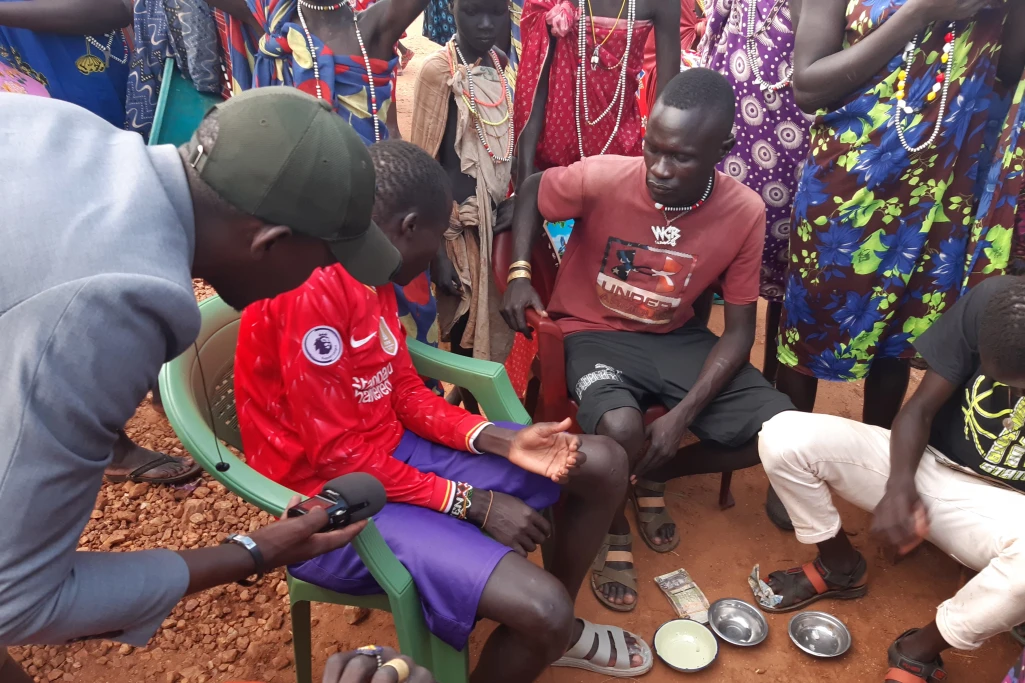
Napopot, a village along the way to Narus in Kapoeta East County, is one of the busier gold trading centers, with local inhabitants selling gold to local dealers. Many local gold miners usually bring their daily earnings and sell them to local dealers.
Singaita FM’s reporter in Kapoeta, William Lonya, visited the mining sites saying the place is so coward, full of women, young girls, and youth. Local dealers sit down with a bundle of cash to buy gold in the evening hours. Some are busy buying foodstuff and clothes after selling the few grams of gold each earned for the day.
It is one of the lucrative business activities for the inhabitants, where they earn a living from gold mining activities. Though they are not making a lot of money from it, some say it is what they say is sustaining them, to buy food and clothes.
You can see people in a group, many in a circle, with guys sitting in a plastic chair and having a tiny weighing scale that determines the gold amount. With a silver vowel tied in small white pieces of polythene bag cut into pieces, said lonya.
Local gold miners say one-gram costs 20,000 SSP, which is equivalent to 47 US dollar, and the least amount each get is 0.1 gram that 2000 SSP, equivalent to 5 USD.
One of the dealers told Singaita 88.3 FM he buys gold from women and resells it to Somalian traders in Kapoeta South County at a price range from 23,500 per gram, the equivalent of 54 US dollars.
Some women told me that extracting gold from the soil is not an easy job because they spend the whole day digging and carrying soil to the water source to filter dirt out and extract gold from it; sometimes, they get nothing.
The gold miners said the business helped them get the money that catered to family needs.
“The gold that we get we sell and buy food for the family, and when we get one point, you sell it at 2000 SSP and buy food for the family that day, and sometimes you can even get one gram depending on how God bless you”.
“If you get two points, you get something like four thousand, and we used to buy food, and this gold has helped us a lot all these years if it is raining, you can buy clothes and animals if you get some good grams.”
“Gold mining has been a big benefit to us since and it is benefitting us a lot at home when we get something from selling the gold we go and buy food and other things for the family some local traders here buy one gram from us at 20,000 SSP we are doing gold mining only when it is raining because water is available and during the rainy season it is a challenge.”
They say it is available during the rainy season. In the dry season, no water, and you can do mining without water which they rely on to filter soil out.
Lino Lomunyen is a gold dealer in Napotpot market. He said he buys one gram of gold from the local miners at 20,000 SSP.
Lino says he encounters losses, especially when he takes the gold to the Kapoeta South market and sells each gram at 23,000 SSP.
He says he is enduring the business even though he experiences a loss because it is the only thing he can do to make an income.
“I used to buy the gold here and sometimes I don’t get profit when I buy one gram at 20,000 SSP it sometimes cuts my money to 17,000 SSP when I go and sell it to big traders in Kapoeta town I loss 3000 SSP and even you bring one hundred thousand pounds it will cut 20000 SSP because when we take to Kapoeta they go and clear some particles in your gold to remain pure gold,” he said.
During the dry season, the inhabitants are very involved in farming and selling sorghum, maize, and others to generate money to feed their families.
South Sudan has substantial gold deposits. Most gold mining takes place in Central Equatoria and the Eastern Equatoria States.